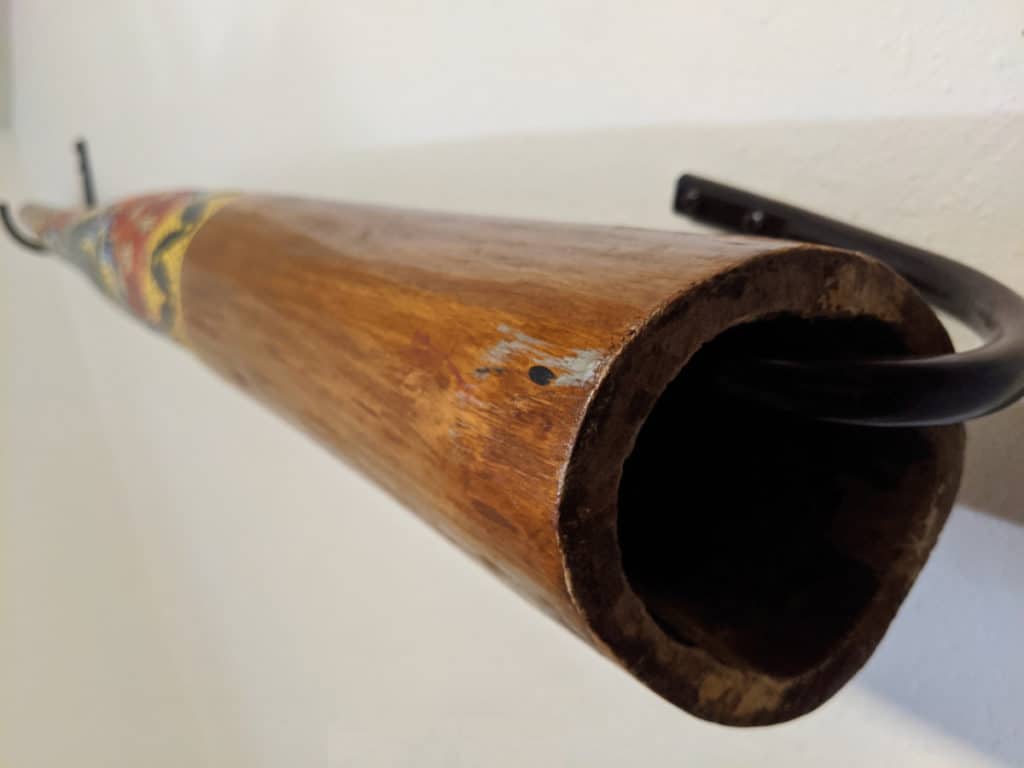This post contains affiliate links. We earn commissions if you purchase products from retailers after clicking on a link from our site. As an Amazon Associate, we earn from qualifying purchases.
You are one of the fortunate few who knows what a didgeridoo is and you are now thinking about learning the instrument. Maybe you’ve tried playing one and you couldn’t get a sound to come out–are didgeridoos hard to play?

By the way, looking for recording equipment and musical instruments? Check out Sweetwater.com for microphones, monitors, audio interface or any other recording gear that you could ever need. (Affiliate Link)
The most difficult thing to figure out for new didgeridoo players is creating a steady tone, and then after that, circular breathing. Several techniques are possible to learn after only 30 days of practice.
You’re super fortunate to find this post, because I actually challenged myself to practice the didgeridoo for 30 days with very little experience in the didgeridoo beforehand–so you can see how much you can learn in just 30 days of practice. Read on to find out more details.
Is the Didgeridoo Difficult to Learn?
The didgeridoo is awesome because it only takes an hour or so to figure out the basic premise, making this one of the most approachable instruments known to man.
I recently spent 30 days focusing on the didgeridoo and the didgeridoo only for an hour a day. You can see my before and after here in this video:
Learning the basics of the didgeridoo is not difficult. Like anything, though, learning to master the art of didgeridoo playing can take years of consistent practice.
I’ll break down the basic parts of learning the didgeridoo and rate the difficulty of part of each part of the instrument. This is assuming you practice for around 30 minutes a day.
| Skill | Difficulty Level | Time to Get to Basic Competency |
| Basic Drone | Beginner | 1 Week |
| Diaphragm Pulsing | Beginner | 1 Week |
| Sound Shaping (wee-you) | Beginner | 2 Weeks |
| Tonguing | Beginner | 2 Weeks |
| Basic Rhythms | Beginner | 3 Weeks |
| Embouchure (flat cheeks and full cheeks) | Intermediate | 3 Weeks |
| Basic Circular Breathing (Cheeks) | Intermediate | 3 Weeks |
| Intermediate Rhythms, e.g. clave | Intermediate | 5 Weeks |
| Trumpet (aka toots) | Intermediate | 6 Weeks |
| Wobble Circular Breathing aka Pulse Breathing (simple rhythms) | Intermediate | 7 Weeks |
Everybody learns at a different pace, so don’t feel worried at all if it takes even double the time I’ve listed. There will be things you will be slower at and things you will be faster at.
Didgeridoo is such a fun instrument because it’s got such a non-judgmental mentality and community. Everyone understands that everyone is coming from a different place musically and that the purpose of playing is to have fun and deepen your enjoyment of life.
Can the Didgeridoo Make It Easier to Harder to Learn?
Choosing the right didgeridoo is crucial to your experience learning the didgeridoo. Didgeridoos vary in weight, length, and clarity of playing.
Case in point: my didgeridoo was more of a tourist instrument rather than designed for real playing.
Because of that, although it is a beautiful instrument, the overtones are not very clear, and some of the sounds always came out mushy no matter what I tried. Your mouth makes some of the difference here, but the didgeridoo can also make a big difference.
Furthermore, some didgeridoos are more fragile–and can crack while playing or in humid conditions, which further disrupts the sound making it more difficult to play.
Most Difficult Parts About Learning the Didgeridoo
As with any instruments, there are some techniques that are difficult. One particular technique that is tricky for many to get a hang of is circular breathing.
Circular Breathing
Circular breathing involves blowing stored air in your cheeks and in your throat out of your mouth while simultaneously inhaling air through your nose. If this sounds tricky to you, you are absolutely right.
Although it is foreign and weird to get the hang of, it doesn’t take too long if you practice often for a few weeks. You’ll be able to at least be able to play with circular breathing for at least 20 seconds.
Some people run into a wall in this technique, and it can take weeks of practice sometimes months. If you haven’t played a wind instrument or swam before, it feels unnatural to constrict your breath and pace it which is necessary for playing the didgeridoo.
All is not lost, though, read the tips later on if you are struggling with circular breathing.
Steady Drone
Although it’s pretty easy to make a drone sound after a bit of practice, it can take a long time making a consistent drone sound. This is related to skill of circular breathing–if you have to stop playing and inhale or if your circular breathing skills are still emerging the drone will stop or become weak-sounding.
It goes back to steady breath control and also a thing called embouchure. Embouchure is essentially the shape of your lips and mouth as you are playing the didgeridoo (and any other human-air powered instrument… except bagpipes).
A strong embouchure is required to keep a steady tone and for crisp vowel-sounds, and that is not a skill that comes automatically. It comes with mindful practice and diligence.
The Wobble (Pulse Breathing)
I said that circular breathing is tricky to learn–well, it gets harder. It’s possible to use your diaphragm to force out air rapidly and with that same force inhale through your nose.
When you are doing circular breathing with your cheeks there is a notable switch between breathing out and breathing in. With the wobble or pulse breathing, the time between breathing out and in is almost instantaneous.
How Long Does the Didgeridoo Take to Learn?
In the video I shared above, I practiced the didgeridoo for 30 days and I made huge improvements in a short period of time. You’ll notice I didn’t become a master–I still feel like a beginner, to be honest, but I was able to learn some of the very basics–enough to play along with music and have fun with the instrument.
I had practiced for an hour a day to get to that point. The amount of hours I think is less important than consistent and focused practice. If you practice for 2 months for 30 minutes a day, you should have no problem in getting basic competency in all the skills I listed in the table above.
I’d say longer than a month because for myself, I did play trumpet in high school–and although they are very different experiences, some skills did transfer over. Furthermore, up to that point I had probably played the didgeridoo for 2-4 hours for the several years I’d owned it.
Tips to Learning the Didgeridoo
If you want to learn as much of the didgeridoo as quickly as possible, there are some critical tips that will help you learn.
I admit, for my 30 days of practice, I floundered a bit for the first few days because I tried to just learn on YouTube. YouTube is phenomenal, but it was like putting together a puzzle from pieces from 50 different puzzles. If you want to learn quickly here are a few tips:
1. Spend Time Learning Circular Breathing Every Day
Your practice time is short, but this one skill is super important to become automatic. Circular breathing is much easier when it’s a habit rather than if you have to focus on it. Daily practice, especially short bursts (like 5 minutes) of circular breathing practice multiple times a day will help you get there.
If you have no idea where to start with circular breathing, check out this YouTube video:
It’s a pretty solid description of what’s necessary and by the end of it you may get it right off the bat.
If you’re struggling with Circular Breathing, there is a course with a ton of content that focuses on this skill from the Didge project here.
2. Get a Teacher, a Course, or a Book
The problem with learning from YouTube or just picking up the didgeridoo and trying to play is that it’s very difficult to know where to start and where to go. A book, a teacher, or a course are so important because they are focused and help walk you through the process of learning.
I personally took all 3 courses from Jonny Cope on Udemy, which you can find here. I absolutely recommend it if you are looking for a systematic approach to learning the different techniques of the didgeridoo. It’s a no-frills course, to be honest, but Jonny does a great job explaining the different techniques.
Another course that I had my eye on was from the Didge Project with AJ Block called the Didgeridoo Skills Course. AJ has some free content that he shares on YouTube that is very good, and I really liked his focus on actual rhythms you can play during a song. To me, his method of teaching was very musical in his free content rather than solely technique. I haven’t taken his course yet but I hope to in the future.
3. Play With Music
It’s a simple thing to overlook, but didgeridoos are instruments! I really felt the potential unlock when I started playing along to music–the songs came to life for me, and it was then that the didgeridoo became really fun to play.
Experiment with different styles and genres of music–you might be surprised which songs have been needing a didgeridoo accompaniment this whole time.
